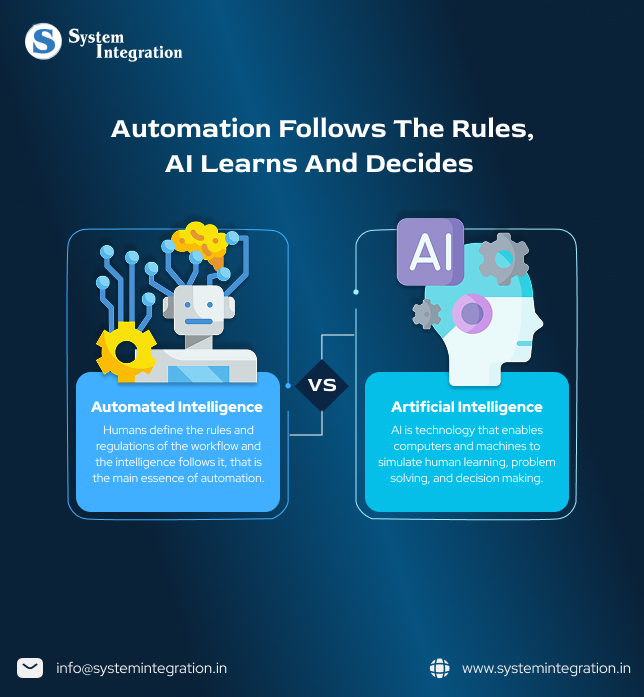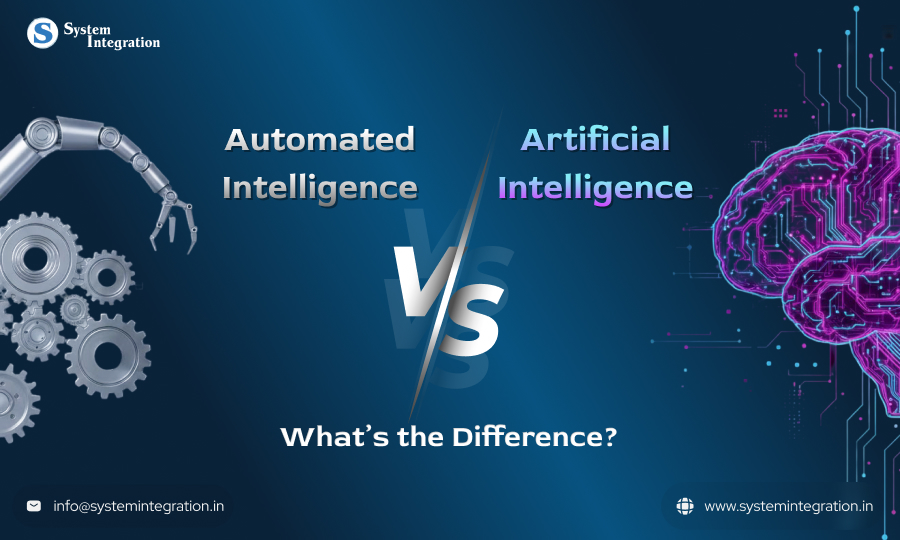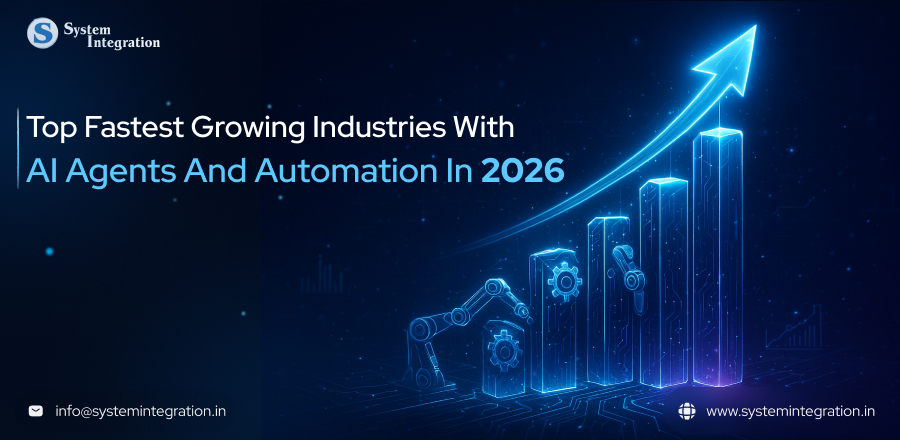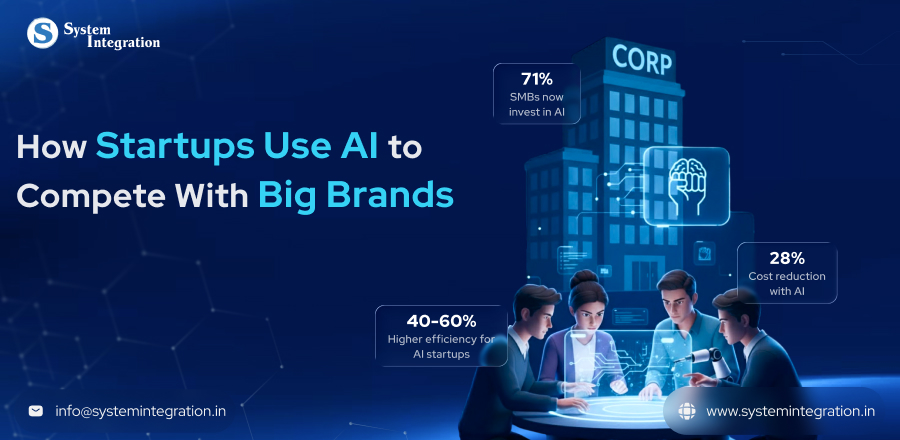Introduction
Many organizations struggle to distinguish between automated intelligence and artificial intelligence which leads to missed opportunities for them to adopt it in their workflow and it affects the efficiency. Automated intelligence works on the predefined rules and predictable workflow while artificial intelligence learns,adopts and is capable of making decisions by analysing complex data.
Most of the businesses are leveraging automated and artificial intelligence as per their needs to get the boost and stand out in the market. However, if you are willing to adopt these technologies in your workflow but are confused between this both?
Don’t worry anymore, in this blog, we will help you distinguish and understand both the technologies so that you can make the informed decision
What is Automated Intelligence?
Humans define the rules and regulations of the workflow and the intelligence follows it, that is the main essence of automation. Its main point is to free humans from repetitive tasks. So that they can focus and work on the other productive tasks.
Uses of Automated Intelligence in Businesses
Customer Support Automation
24/7 AI bots and virtual assistants AI-driven bots provided response to frequently asked questions freeing humans from repetitive work, the result being reduced first reply time and consistent personalized exprience.
No/Low Code Implementation
Users can design workflows by drag and drop feature by connecting the prebuilt components. This allows the quick deployment without the training from the scratch.
Marketing Personalization
AI automatically adapts each marketing message to customers’ behaviour, demographics and order history for increased engagement and conversions. It helps you save on ad spend through only showing relevant ads (keeping your CPCs low) as well as pinpoints exactly who’s going to buy.
Supply Chain Optimization
AI automates demand forecasts, route optimization and inventory management that trim delays and costs, while enhancing visibility and efficiency throughout the supply chain via real-time tracking and predictive analytics.
HR and Recruitment
AI solutions simplify the hiring process by reviewing resumes, identifying candidates for positions and scheduling interviews, so they increase efficiency while limiting bias and providing ongoing performance feedback on employees.
What is Artificial Intelligence?
AI is a field of computer science that enables machines to act like humans in learning from the current data and making decisions on its own. Basically it’s trained to perform tasks on its own which typically requires human intelligence. It can mimic human behaviour and interact with users for better relations between business and its customers. This increases the chances of user sustainability.
Uses of Artificial Intelligence in Businesses
Predictive Analytics
AI processes historical data to anticipate what can be expected in the future, enabling businesses to make predictions on demand, control inventory and notice risks or opportunities more effectively for making critical decisions that rely on accurate data.
Fraud Detection
AI detects strange or suspicious transaction patterns and transactions which don’t make sense, where fraud attempts are stopped before they even happen in real-time to further secure financial systems and protect commercial interests.
Process Automation
With AI powered automation, routine business activities such as data entry, invoicing or report creation are simplified. This results in a time savings, less errors and higher productivity.
Sales Forecasting
AI models analyze user data and historical sales to estimate future revenue trends, enabling companies to establish reasonable targets, handle stocks better, and optimize pricing scenarios.
Cybersecurity Enhancement
AI driven systems continually oversee networks, identify threats more quickly than humans, and automatically counter cyberattacks with the aim to make the whole system and user data secure.

Automated Intelligence vs Artificial Intelligence: Key Differences
| Aspect | Automated Intelligence | Artificial Intelligence (AI) |
|---|---|---|
| Definition | These include the rule-based systems, where prior instructions are followed to automate repetitive tasks. | Imitate human intelligence to learn, think, decide for ourselves. |
| Learning Capability | Incapable of learning or responding, bound by a static set of coded rules. | Never stops learning from data, increasing the accuracy and efficiency the longer it runs |
| Decision making process | Determined by the if-then rule or logic | Utilizes algorithms and data patterns to intelligently take context-aware decisions. |
| Complexity level | Simple and to the point, best used in day-to-day procedures. | Complex, dynamic; able to deal with multi-dimensional problems. |
| Goal | To drive efficiency by automating tasks that were repetitive and rule-based. | To make machines think, learn and act like a human. |
Benefits of Automated Intelligence and Artificial Intelligence
Increased Efficiency
AI executes repetitive work faster and with more precision than a human can, eliminating manual labor, mitigating errors and helping to increase general business productivity.
Cost Savings
With more efficient operations and reduced costs by automating repetitive manual processes, companies save time and pay less for labor which increases available time and resources to strategic value-add activities.
Consistency and Accuracy
Automated procedures perform tasks repeatedly with no fatigue or distractions, which results in extremely accurate and less error incurred processes such as entering data or creating reports.
Improved Time Management
That’s where automation comes in, which lets employees not get bogged down with tedious tasks and instead concentrate on innovation, decision-making, and growing their business.
Scalability
Computerized systems can be expanded to accommodate an increased workload or business growth inexpensively and without additional staffing.
Consideration Before Adopting Both Of Them
- Have A Clear Goal: comprehend your needs that you want AI to address for better experience.
- Establish The Matrix: define success criteria to measure performance and ROI once the AI is implemented.
- Check The Technical Support: verify if your current technologies can support the AI solution, considering the software and integration requirements.
- Start With A Small Step: start by automating the small task before scaling up to check for the efficiency.
- Establish Governance And Ethics: create a clear governance structure, including the policies for ethical cases, data privacy and compliance.
Parting Words
So what’s next? Every company needs the assistance in automating their workflow for more efficient and effective management. This also helps in taking future and predictive decisions for your organization as it analyzes large scale data in a few minutes.
BMVSI, provides best workflow automation service for automating the business tasks and streamline the operations. We focus on developing solutions that deliver measurable results.
FAQs
ઓટોમેટેડ ઇન્ટેલિજન્સ જટિલ વ્યવસાય પ્રક્રિયાઓને સ્વચાલિત કરવા માટે કૃત્રિમ બુદ્ધિ, મશીન લર્નિંગ અને RPA ને જોડે છે. આ સિસ્ટમને જટિલ બહુ-પગલાંના કાર્યોને હેન્ડલ કરવાની મંજૂરી આપે છે.
AI teaches software to think and act like humans in various ways, while automated intelligence automates the daily tasks. Automation is structured for ruled based tasks and AI can handle more complex tasks.
Learning differs because automated systems follows pre programmed rules and static logics, whereas AI keeps learning, adopts, and analyses current data for better decisions.
Yes, firms can use AI and automated intelligence together, as they can help in scaling up the processes and increase the accuracy and improve the decision making.
Automation is generally easy to implement, particularly for the rule based tasks. However, AI requires advanced infrastructure and a more complex development cycle.





